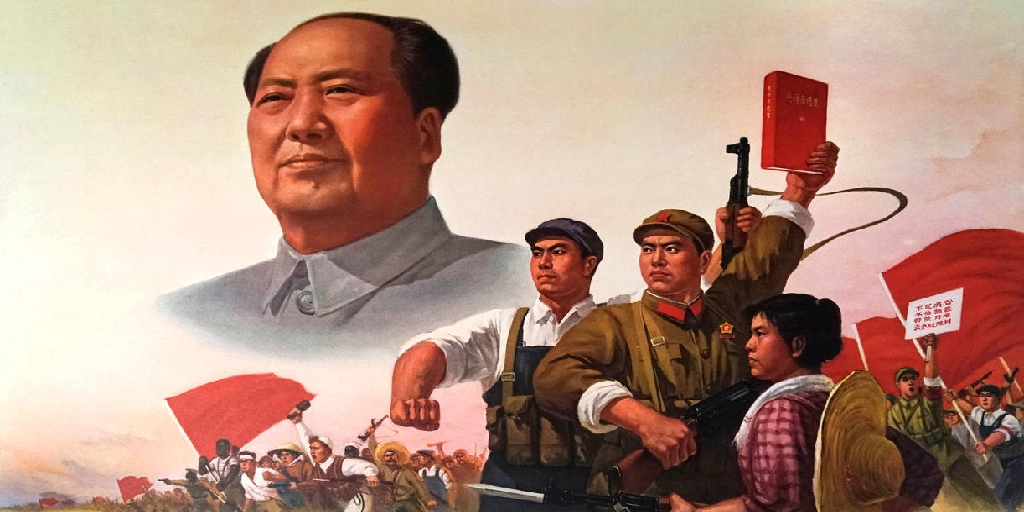China’s Cultural Revolution and the Social Justice Left
In a recent debate between Jordan Peterson and Michael Eric Dyson, Peterson asked a question: When might it be evident that the Left has gone to far?
In other words, what is the limiting principle in liberalism—when is an idea pushed to a point where it becomes so contrary to human reason or decency that to enact it would cause serious harm? Peterson wasn’t talking about acts of violence, which he noted is something that all people of good will are against. “There are sets of ideas in radical leftist thinking . . . that led to the catastrophes of the 20th century,” he said. “That was at the level of ideas, not at the level of violent action.”
So—when has the Left gone too far? Dyson had no answer, instead resorting to name-calling. The real answer to Peterson’s question can be found in China’s Cultural Revolution: Remembering the Past to Prevent Repeating It, an exhibit recently mounted at the Katzen Arts Center at American University in Washington, D.C.
It was pretty basic—just dry-mounted photographs bearing captions that looked like they’d come out of a computer printer. No frames, no elegant typeface that one sees in most museum exhibits. Moreover, it was barely advertised. China’s Cultural Revolution, funded by the U.S.-China Policy Foundation, was in the rotunda of AU’s Katzen Arts Center for a few weeks in May and June.
Its content is available, though, in books and photographs, and its subject matter should be of interest to the general public, and in particular, to anyone engaged in political debate in America. The Cultural Revolution period in China (1966-1976) has a deep and disturbing correlation to the campus Left today. The shocking images on display provide the unsettling answer to Peterson’s question of what happens when the Left goes too far. When Marxist ideas are put into action, people are tortured, centuries-old institutions come under attack, and the bodies begin to pile up. Deep in his subconscious, Michael Eric Dyson knows this.
All Must “Hold High the Great Banner”
The Cultural Revolution was the brainchild of China’s “Great Helmsman,” Mao Zedong (1893-1976), the chairman of the Chinese Communist Party and one of its founders. After the failure of Mao’s economic Great Leap Forward, a program of agricultural collectivization that resulted in tens of millions of deaths, Mao saw the Cultural Revolution as a way to turn things around. “Our objective is to struggle against and crush those persons in authority who are taking the capitalist road . . . so as to facilitate the consolidation and development of the socialist system,” he said in his “Sixteen Points” declaration of 1966.
In The People’s Revolution: A Cultural History (2016), China expert Frank Dikötter observes that Mao hoped his movement would make China the pinnacle of the socialist universe and make him “the man who leads planet Earth into communism.” When Soviet leader Nikita Khrushchev denounced Stalin in 1956, Mao took that as a sign of weakness on the part of Khrushchev, a weakness to be exploited by Mao, who saw a clear path to surpassing Stalin himself in greatness. Toward this end, he launched the Cultural Revolution. A flyer from the Katzen Arts Center exhibit outlines the plan:
The whole party must follow Comrade Mao Zedong’s instructions, hold high the great banner of the proletarian Cultural Revolution, thoroughly expose the reactionary bourgeois stand of those so called ‘academic authorities’ who oppose the party and socialism, thoroughly criticize and repudiate the reactionary bourgeois ideas in the sphere of academic work, education, journalism, literature, art and publishing, and seize the leadership in these cultural spheres.
The result of this thinking, and the atmosphere of denunciation it spawned, is evident in the exhibit’s photographs. These are heart-rending images of purges, torture, rallies, propaganda posters, and executions. Urban professionals, middle-class merchants, those who wore ties or showed other signs of being influenced by Western, bourgeois ways, were targeted. “We were told that we needed to use violence to destroy a class, spiritually and physically,” one eyewitness account reveals. “That was justification enough for torturing someone. They weren’t considered human anymore.”
Students attacked their professors, as they were considered out-of-touch intellectuals who failed to serve the needs of the rural masses. Red Guards destroyed Buddhist statues and burned down Catholic churches, as they represented a “black religion” and “old thinking.” The Peking Union Medical College Hospital, founded in Beijing by the Rockefeller Foundation in 1921, was renamed the “anti-Imperialist Hospital.” Wang Guangmei, the wife of President Liu Shaoqui, who was purged when he was deemed insufficiently committed to Mao, was forced to wear a necklace of ping pong balls as a mockery of her pearls and formal wear. (Liu died under torture in late 1969, but was posthumously rehabilitated by Deng Xiaoping’s government in 1980 and granted a national memorial service.) Women’s choirs were forced to sing Mao’s praises. Individuals accused of bourgeois deviationism had to stand and wear dunce caps announcing their crimes.
There Are Two Extremes to Guard Against, Not Just One
Since World War II, Western culture has erected a very elaborate and sensitive early warning system for fascism. A politician, public figure, or celebrity who trades in anti-Semitism is quickly reproached, and his or her reputation justifiably impugned. The Republican Party is frequently examined for fringe characters who preach intolerance. When white nationalists marched in Charlottesville in 2017, the media was there, and reporters continue to follow the trail of those who were at the march.
The spotlight on the far Right is the sign of a healthy culture that is on guard against extremism. But what about the “Antifa” brawlers, radical environmentalists, restaurant-haunting Democratic Socialists of America harassers, and others on the extreme Left?
What we see happening on our campuses is college students shouting speakers down; activists from Black Lives Matter calling for dead cops; censors laying down the law about what entertainment can be provided to or what kinds of art can be made or seen by students. Academia is top-heavy with socialists like Dyson, a Georgetown University sociologist, who cannot demarcate a limiting principal for their ideology. China’s Cultural Revolution: Remembering the Past to Prevent Repeating It blipped by for a few weeks in the summer in our nation’s capital, where it was largely missed by the students, reporters, and academics who most need to see it.



